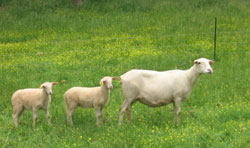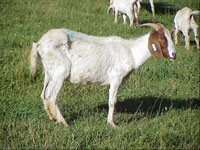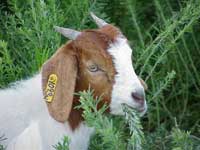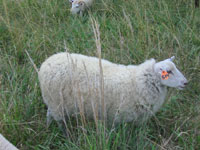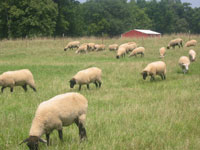skip
navigation  |
800-411-3222 (Español)
Managing Internal Parasites in Sheep and Goats |
| By Margo Hale NCAT Agriculture Specialist Published 2006 ATTRA Publication #IP293 |
The
printable PDF version of the entire document is available
at: http://attra.ncat.org/attra-pub/PDF/parasitesheep.pdf 8 pages — 553K Download Acrobat Reader |
Abstract
Internal parasite management, especially of Haemonchus contortus (barberpole worm, stomach worm), is a primary concern for the majority of sheep and goat producers. These parasites have become more difficult to manage because of developed resistance to nearly all available dewormers. This publication discusses new techniques to manage parasites and to prolong the efficacy of dewormers. New management tools that remain under investigation are also discussed. A list of resources follows the narrative. Table of Contents
IntroductionThe management of internal parasites, primarily Haemonchus contortus (barberpole worm), is considered by many to be the biggest production concern for small ruminants. “There are many important diseases of sheep and goats,” notes University of Georgia researcher Ray Kaplan, DVM, PhD, “but none are as ubiquitous or present as direct a threat to the health of goats as internal parasites.” (Kaplan, 2004a). The cost of internal parasite infection includes treatment expense, reduced animal weight gains, and even animal death. These parasites are difficult to manage because on some farms they have developed resistance to all available commercial dewormers. (Zajac and Gipson, 2000) Resistance to dewormers is now seen worldwide. (Kaplan, 2004b) Producers can no longer rely on drugs alone to control internal parasites. Rather, an integrated approach that relies on sustainable methods to manage internal parasites should be employed. Parasite Primer
Internal parasites (worms) exist by feeding off of their host. Some types do this directly, by attaching to the wall of the digestive system and feeding on the host’s blood. These types of parasites cause anemia in the host, as well as other symptoms. Haemonchus contortus (barberpole worm) is one example of this type. Others live off the nutrients eaten by the host; these cause weight loss but not anemia. Mature parasites breed inside the host and “lay eggs,” which pass through the host and are shed in the feces. After the eggs pass out of the host, they hatch into larvae. Warm, humid conditions encourage hatching. The larvae need moisture to develop and move. They migrate out of the feces and up blades of grass (usually 1 to 2 inches). When an animal (sheep or goat) grazes, they may take in parasite larvae along with the grass blade. An animal can also pick up parasite larvae by eating from a feed trough that is contaminated by manure. Parasite numbers increase over time when conditions are favorable (warm, wet). Internal parasites get out of control and cause damage when their numbers grow beyond what the animal can tolerate. In order to manage internal parasites, it is important to understand the parasite cycle and factors that encourage their production.
Parasitism
Animals raised in confinement or on pasture-based systems will almost certainly be exposed to internal parasites at some point in their lives. Dry environments, such as arid rangelands, will pose less of a threat for parasite infections. Warm, humid climates are ideal for worms, and therefore animals will have more problems with internal parasites in these climates. Sheep and goats should be managed so that parasitism is not evident. Sheep and goats will always host some level of parasite burden. Certain signs of parasitism are seen when the parasite load becomes excessive or when the animal’s immunity can no longer overcome the adverse effects of the parasitism. (Scarfe, 1993) Young animals and those with weakened immune systems due to other diseases are most affected by internal parasitism. A combination of treatment and management is necessary to control parasitism so that it will not cause economic loss to the producer. (Scarfe, 1993)
While it is ideal to manage animals so there are no visible effects of parasitism, some will nonetheless succumb to the burden of internal parasites. Learn to recognize the signs of internal parasite infections and offer early treatment.
Resistance to DewormersProducers were once instructed to deworm all of their animals every three to six months. Many producers dewormed even more often, as often as every four weeks in humid climates. It is now known that this practice is not sustainable. Drug resistance is the ability of worms in a population to survive drug treatments that are generally effective against the same species and stage of infection at the same dose rate. (Kaplan, 2004b) Over-use of dewormers has led to resistance, and available dewormers are now ineffective. In an article from 1993, David Scarfe predicted the development of drug resistance.
Scarfe recognized the unsustainable practices that were being used long before parasites were resistant to dewormers in the U.S. Some farms still have dewormers that continue to work, while others have no effective dewormers. This is a problem because no new dewormers for sheep and goats are currently under development. (Kaplan, 2004b) Development of Resistance to DewormersInternal parasites, especially H. contortus, have developed drug resistance. Drug treatment gets rid of the worms that are susceptible to that particular drug; resistant parasites survive and pass on “resistant” genes. Worms that are not treated are called “refugia.” The concept of refugia has been largely overlooked in the past. Having some worms in refugia (not treated) insures that a level of genes remain sensitive to dewormers. (Kaplan, n.d.) A surviving population of untreated worms dilutes the frequency of resistant genes. Consequently, when a dewormer is required, it will be effective because the worms will be susceptible to treatment. (Kaplan, n.d.) When fewer numbers of animals receive treatment, the refugia population remains large. The more refugia, the better. Sustainable techniques, such as FAMACHA©, fight drug resistance by increasing refugia. In contrast, several practices accelerate drug resistance. They include frequent deworming (more than three times a year), underdosing (often caused by miscalculation of body weight), treating and moving to clean pasture, and treating all animals, regardless of need. These practices lead to resistance because they decrease the number of worms susceptible to dewormers (refugia). Since no dewormer is 100 percent effective 100 percent of the time, worms that survive a dose of dewormer are resistant to that dewormer. Frequent deworming increases the rate resistance develops. Each time animals are dewormed, the susceptible worms are killed. The strong ones survive and lead to a population of very resistant worms. Underdosing causes larger numbers of stronger worms to survive. The weakest, most susceptible worms are killed. But because of the weak dose, more of the stronger worms will be able to survive and reproduce, creating a population of stronger worms. Once an animal has been treated, only resistant worms remain. If the animals are moved to a clean pasture they deposit only resistant worms on the pasture. There are no susceptible worms to dilute the worm population. Treating all animals regardless of need ignores the importance of refugia and will lead, in time, to a population of worms unkillable by dewormers.
Pasture ManagementNumerous techniques can be used to control parasitism. Pasture management should be a primary tool to control internal parasites. Sheep and goats ingest infective parasite larvae from pasture. The rate at which they are ingested can be controlled through pasture management.
Most worm larvae crawl up the plant only one to two inches from the ground. Preventing animals from grazing below that point decreases the number of worm larvae ingested. Animals that eat closer to the ground tend to have more problems with internal parasites. It is important to monitor animals and the pasture. Allowing animals to graze pastures too short results in more parasites consumed and reduced feed intake, therefore harming the animal in two ways. It also inhibits pasture regrowth. Larvae migrate no more than 12 inches from a manure pile. Livestock not forced to eat close to their own manure will consume fewer larvae. Providing areas where animals can browse (eat brush, small trees, etc.) and eat higher off of the ground helps to control parasite problems.
Decreasing the stocking rate decreases the number of worms spread on a pasture. The more animals you have on one pasture, the more densely the worms are deposited. Animals on densely stocked pastures are more likely to have parasite problems. Grazing sheep and goats with cattle, or in a rotation with cattle, can also reduce internal parasite problems. Cattle do not share the same internal parasites as sheep and goats. Cattle consume sheep and goat parasite larvae, which helps “clean” the pasture for the small ruminants. Certain forages have also been shown to control parasite problems. Tannin-rich forages, such as sericea lespedeza, have been shown to help reduce internal parasite egg counts. (Min and Hart, 2003; Shaik et al., 2004) Other plants, including plantain, chicory, and wormwood, also have an anthelmintic effect, although wormwood also produces toxic compounds. Providing tannin-rich forages and diverse pastures can help animals battle internal parasites. New TechniquesFAMACHA© FAMACHA© is a system for classifying animals into categories based upon level of anemia. (Kaplan, n.d.) It was developed in South Africa and has been validated in the U.S.
This system identifies anemic animals on a 1 to 5 scale by examining the eyelids of sheep and goats. The system treats only animals that are anemic (a sign of parasitism). This reduces the use of dewormers, slows the development of resistant worms, and saves the producer money. Most importantly, it also allows the producer to select animals that are healthier. By breeding the healthiest animals and culling the weaker individuals, the flock or herd becomes stronger over time. FAMACHA© is only effective for the treatment of H. contortus. Producers must be trained by a veterinarian or other trained animal health professional in order to use FAMACHA©. (Kaplan, n.d.) However, this technique is simple to learn and quick and easy to use. For more information on FAMACHA©, see Other Resources.
Other TechniquesSelecting Resistant Animals
Several other techniques can be used to help manage internal parasites. There are several breeds of sheep and goats that show resistance to parasites. There is something in their genetic makeup that causes them to host a smaller parasite load. Breeds such as Gulf Coast Native, St. Croix, Katahdin, and Barbados Blackbelly show an increased resistance to parasite loads. Spanish, Myotonic, and Kiko goat breeds have also shown a tolerance to parasites. Resistance will vary within breeds as well. Some animals, regardless of breed, will be more resistant to parasites than others. Having parasite-resistant animals will decrease the need for dewormers. Within any breed, certain animals are more tolerant of parasite loads than others. These resilient animals can host a large parasite burden, yet show few signs of parasitism. Some animals will carry a heavier parasite load than others. Research shows that 20 to 30 percent of the animals carry 70 to 80 percent of the worms. (Kaplan, n.d.) Producers should cull animals that are always “wormy,” and select for animals that have a natural resistance or tolerance to a slight parasite burden. The FAMACHA© system will help you identify those more tolerant animals. Copper Wire ParticlesRecent research has been performed on the use of copper wire particles to control internal parasites. Studies show that copper wire particle boluses administered to lambs decrease parasite loads. (Burke et al., 2004) However, higher doses may increase the risk for copper toxicity in sheep. Copper wire particle treatments do not appear to be effective in mature sheep (Burke et al., 2005), but may work in mature goats. (Chartier et al., 2000) Research is still underway on this technique, especially for long-term studies to determine the copper levels that are toxic to sheep. Nematode-Trapping FungusAnother tool currently being researched is the use of nematode-trapping fungus. This fungus traps parasite larva in the feces, interrupting its life cycle. Research has shown that it is “effective in significantly reducing development of L3 and appears to be an effective tool for biocontrol of parasitic nematodes in goats.” (Terrill et al., 2004) The use of these fungi is still being researched.
ConclusionControl of internal parasites in sheep and goats can be a daunting task. Previous control methods are no longer viable, so new techniques must be used. Techniques such as increased pasture management, Smart Drenching, FAMACHA©, and selecting parasite-resistant animals can help to manage internal parasites. These techniques reduce dependence on dewormers and lead to a more sustainable parasite management program. New techniques, such as copper wire particles and nematode-trapping fungus, are being researched and developed. These developments may increase the tools available to battle internal parasites of small ruminants. ResourcesATTRA Publications
Other ResourcesSouthern Consortium for Small Ruminant Parasite Control Association of Small Ruminant Practitioners
ReferencesBurke, J., J. Miller, D. Brauer. 2005. The effectiveness of copper oxide wire particles as an anthelmintic in pregnant ewes and safety to offspring. Veterinary Parasitology, 131, 291-297
Managing Internal Parasites in Sheep and Goats
|
||||||||||||||||||||||||||||||||||
|
Site Map | Comments | Disclaimer | Privacy Policy | Webmaster Copyright © NCAT 1997-2009. All Rights Reserved. | ||||||||||||||||||||||||||||||||||


